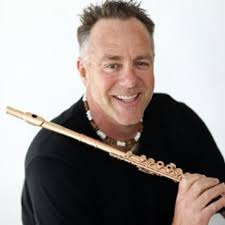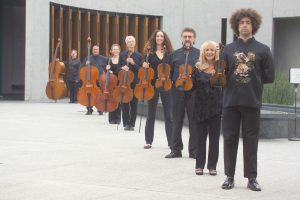Chestnuts Roasting on a Different Fire
The Hutchins Consort offers (mostly) well known fare in unusual settings
Friday evening’s Hutchins Consort performance at St. Andrews Episcopal Church in Encinitas offered pieces that are mostly repertory staples. The twist was that they utilized Dr. Carleen Hutchins’ unique, “scaled violin” octet.
Hutchins’ (1911-2009) life as a luthier and researcher is a fascinating story redolent of a search for the Holy Grail. Hutchins had wondered why some string instruments sounded better than others and dedicated her life to searching for the answer. In 1949, she began collaborating with Frederick A. Saunders (1875-1963), a retired Harvard physicist who had been conducting research on violin acoustics since the early 1930s. Hutchins invented a process called “free plate tuning” that allowed her to test the acoustics of a string instrument’s top and bottom before gluing it together. Deriving an algorithm for string length and body mass after scientifically analyzing a particularly fine Stradivarius violin and utilizing her shared research findings with Saunders, she designed and constructed a “consort” of eight different instruments ranging from a tiny 18.5 inch “treble violin” to a 7.2 foot contrabass.
Hutchins’ complete set of instruments were the subject of a featured exhibition at the Metropolitan Museum of Art in New York from 2002 to 2003. Entitled “The New Violin Family: Augmenting the String Section,” the exhibit crowned her already impressive body of work which included more than 100 technical publications, two volumes of collected papers on violin acoustics, four grants from the Martha Baird Rockefeller Fund for Music, two Guggenheim Fellowships, an Honorary Fellowship from the Acoustical Society of America, and four honorary doctorates.
The Hutchins Consort, led by Artistic Director Joseph McNalley, has done a yeoman’s work in preserving this unique collection and presenting it in new and innovative programs. Several composers, including Pulitzer Prize winner Henry Brant, have chosen to compose specifically for this consort but to date, most of the pieces in the ensemble’s active repertoire of over 300 works are arrangements. The vast majority of these works were arranged by Mr. McNalley himself, although other members and guests of the Consort have contributed meaningfully.
Friday’s program opened with the oft-encountered Serenade In C by Tchaikovsky in an arrangement by Mr. McNalley. The choice of the Serenade as the opening work could have been better thought out as the upper three string players (Steve Huber, Treble Violin; Bethany Grace, Soprano Violin; and Chris Woods, Mezzo Violin) seemed to be a bit out of sorts with each other, and intonational differences abounded. Considering the unique dimensions of these instruments when compared to the musicians’ usual, traditionally scaled violins, one can only imagine the difficulty in getting exact finger placements. The Serenade is generally played with a full string orchestra complement, but in this arrangement, the parts are much more exposed which exacerbated the issues. The low strings, on the other hand, played exemplarily. The resonant timbres and richly expressive playing of Pete Jacobson (Tenor Violin), Alex Greenbaum (Baritone Violin), Joe McNalley (Bass Violin) and Tim McNalley (Contrabass Violin) were a delight. Of special note was the outrageously gorgeous playing of Erin Breene, on the Alto Violin (akin to a high cello.)
Following on the heels of the Tchaikovsky was one of the evening’s highlights, Edward Elgar’s “Sospiri,” Op. 70, an adagio that was originally conceived as a violin/piano duo and a companion piece to his famous “Salut d’amour.” Its working title had been “Soupir d’Amour” (“Sigh of Love”) but mid-composition, Elgar realized that the piece fit neither the title nor the instrumentation. “Sospiri” became buried in Elgar’s vast oeuvre but benefited tremendously from this delicious orchestration (again, by McNalley). Hearing this piece with the Hutchins instruments was revelatory. The richness of these instruments must be heard to be appreciated, but, suffice it to say, the entire sanctuary fairly bloomed with a unique and extravagant string sound. The piece itself was brilliant, too, and one can only hope to encounter “Sospiri” more often in any arrangement. To my ears, it is one of the very best pieces that Elgar ever wrote.
Following the intermission, the audience was treated to a unique arrangement of Modest Mussorgsky’s Pictures at an Exhibition. The work, originally written for the piano, has been a repertory staple for nearly one hundred years in the orchestration of Maurice Ravel. In the Hutchins’ orchestration, McNalley returned to the original piano score and, in program notes delivered from the stage, explained that he chose to “de-Frenchify” Ravel’s famous treatment, especially by restoring the original’s more pungent harmonies. The result was refreshing, and, although it will challenge a listener’s preconception of the piece, it offered a fresh option to a now relatively moldy staple. Harp was chosen to supplement the instrumentation, and although there was a certain reassurance from its familiar use in the Ravel arrangement, the same effects could have been achieved by keeping all of the passages “in house” and distributing them throughout the various strings of the Consort.
By the time the final offering arrived, Mahler’s “Adagietto” from Symphony No. 5, the Consort was functioning like a well-oiled, finely tuned, high performance race car. The upper strings found one another; the low strings continued to flourish, and the addition of Elena Mashkovtseva’s harp and Tim McNalley’s accordion sounded perfectly placed and entirely appropriate. The “Adagietto” is a little bit like vanilla ice cream: if you don’t like either one, there’s probably something wrong with your “liker.” It was the perfect close to a very pleasing concert, offering a harbor of warmth from the unusual San Diego rain and cold that prevailed outside.

Yochanan Sebastian Winston, Ph.D. has performed throughout the United States, Europe and Latin America. His repertoire spans classical, jazz, klezmer, new age, contemporary, rock & roll and pop and is very active as a composer. Dr. Winston holds a Ph.D. from the UCSD, a Diplôme from the Conservatoire National de Region de Boulogne-Billancourt (France), and a Master’s and Bachelor’s of Music from the Manhattan School of Music in New York City.

